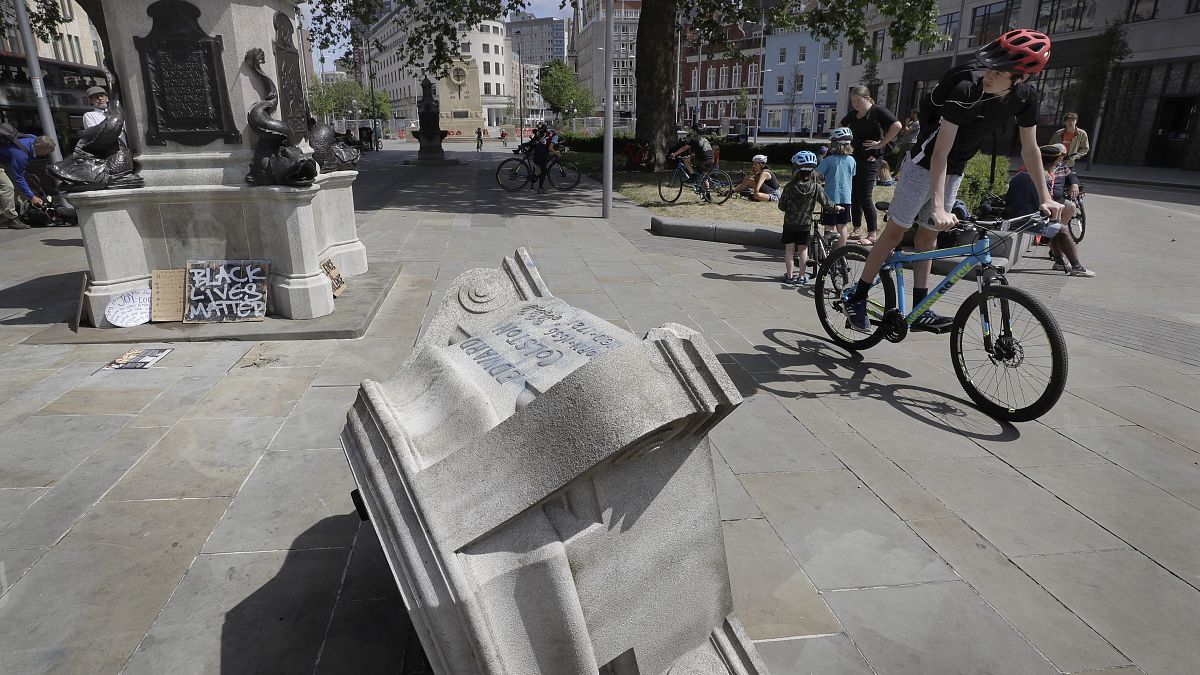The statue of Edward Colston had been at the centre of a controversy for years. On Sunday, anti-racism protesters toppled it from its plinth and tipped it into a river.
Anti-racism protesters in the English city of Bristol tore down the controversial statue of slave trader Edward Colston on Sunday after years of wrangling over his checkered legacy.
The 5.5-metre statue was toppled from its plinth and then thrown in the River Avon towards the end of a protest attended by about 10,000 people to denounce institutional racism.
The march, like similar ones across Europe, was organised in solidarity to the Black Lives Matter movement following the death of African American George Floyd last month in Minneapolis, US.
Who was Edward Colston?
Colston was born to a wealthy merchant family in Bristol but was educated in London, where he was based for most of his working life, according to the Museum of Bristol's website.
He initially traded on his own account in Europe in woollen textiles and wine but bought shares in the Royal African Company (RAC) in 1680. Only RAC members were allowed to trade with Africa for gold, ivory and enslaved Africans.
RAC ships, which departed from Bristol, Liverpool and London, transported about 100,000 west African salves to the Caribbean and the Americas between 1672 and 1689. All of them were branded on the chest with the company's initials.
According to the History of Parliament's website, Colston "made the bulk of his fortune" from the slave trade".
"The 1680s were undoubtedly the most lucrative in business, and according to one account, he was said to have owned over 40 ships," it added.
He used his profits to move into money-lending, offering loans to governments before selling his RAC stocks to King William III.
He then retired in Surrey and started funding a series of charitable projects, primarily in Bristol and London, benefitting schools, almshouses, hospitals and churches.
He briefly went into politics as an MP between 1710 and 1713, although in his seventies by then, he rarely attended Parliament in London.
He died at his home in Surrey in 1721 and was buried in All Saints Church in Bristol.
Beyond the now-fallen statue, Bristol celebrated him by naming buildings and streets after him, including the Colston concert hall, Colston Tower, and Colston Avenue.
'Statue should have been taken down a long time ago'
The removal of the statue has been denounced by prominent politicians including Sajid Javid who said on Twitter: "I detest how Edward Colston profited from the slave trade. But this is not OK".
"If Bristolians want to remove a monument it should be done democratically — not by criminal damage," he added.
The leader of the main opposition Labour Party, Keir Starmer, told LBC radio station on Monday that it was "completely wrong to pull a statue down like that".
"But that statue should have been taken down a long, long time ago," he said, adding that "he (Edward Colston) should not be a statue in Bristol or anywhere else".
A criminal investigation has been launched to identify those involved in the statue's removal, police said.
'Active role on enslavement' vs 'greatest benefactor'
Author and professor Kate Williams, who teaches history at the University of Reading, has however taken to Twitter to highlight the difficulty in removing the statue or even altering its plaque.
She flagged that authorities agreed to add Colston's involvement in the slave trade on the statue's plaque in 2018 but that no changes had yet been made.
According to Williams, Bristol City Council wanted to the plaque to read that "Edward Colston played an active role in the enslavement of over 84,000 Africans (including 12,000 children) of whom 19,000 died en route to the Caribbean and America", that he "invested in the Spanish slave trade and in slave-produced sugar" and that "Bristolians who did not subscribe to his religious and political beliefs were not allowed to benefit from his charities".
Some councillors objected while the Society of Merchant Venturers pushed for various changes, including the removal of the reference to African children and to Colston's selective philanthropy.
They instead proposed that the plaque states that Colston "was one of this city's greatest benefactors" and that the statue was erected "in 1895 to commemorate his philanthropy".
"A significant proportion of Colston's wealth came from investments in slave trading, sugar and other slave-produced goods. As an official of the Royal African Company from 1680 to 1692, he was also involved in the transportation of approximately 84,000 enslaved African men, women and young children, of whom 19,000 died on voyages from West Africa to the Caribbean and the Americas", their proposed plaque would also read.
But the council rejected the modifications.
Williams underlines that the Colston statue's case epitomises "so many of the big questions we must confront in this country as so much of this country's riches gained in the past stem from the misery of others".
